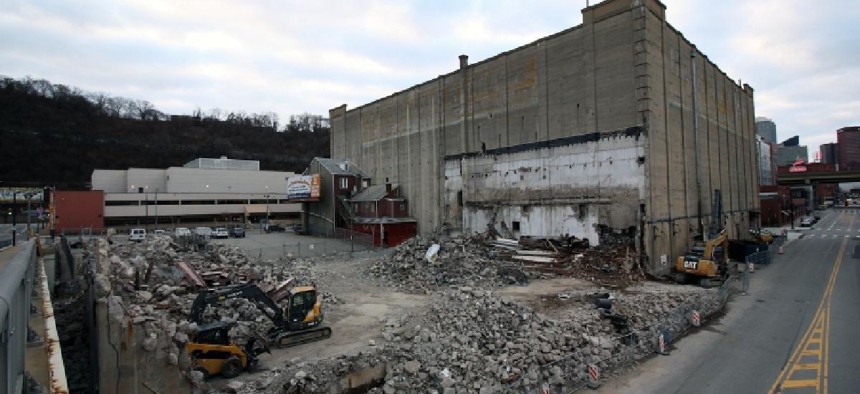Opinion
Pennsylvania’s History Code fails the sniff test, needs a rewrite

Pennsylvania's History Code is in need of a rewrite. David Rotenstein
Tucked away inside an obscure piece of Pennsylvania law called the Pennsylvania History Code are provisions that require state agencies to take steps to protect historic places. Commonwealth agencies planning to demolish, alter, or sell historically significant properties are required to “consult” with the Pennsylvania Historical and Museum Commission (PHMC). This consultation requirement extends to private sector entities, including industries and developers, that get state permits and licenses. An example from Pittsburgh underscores why it is time for legislative action to repeal parts of the History Code.
RELATED ARTICLES
Completed in 1930, the Federal Cold Storage Company building is a relic of Pittsburgh’s industrial past. The mammoth, seven-story concrete building is one of 66 significant sites inside the Strip Historic District, which, in 2014, was listed in the National Register of Historic Places. It once played key roles in local, regional and national food distribution chains. At the end of World War II, a warehouse strike kept wholesalers and retailers from removing their fruits and vegetables. This had significant impacts on military and civilian supply chains.
There is no doubt that the Federal Cold Storage Company building is historic and that it played an important part in Pittsburgh’s history. Its importance is laid out in historic preservation documents, books and articles.
Agencies and their licensees notify the PHMC when a historic building like the Federal Cold Storage Company building or an archaeological site may be endangered by state-permitted activities. Unlike federal environmental and historic preservation laws, the Pennsylvania History Code doesn’t have a clear-cut regulatory review process. In fact, the provision is what historic preservation professionals call a “Little 106 Law” because it’s a shadow of its federal counterpart, Section 106 of the National Historic Preservation Act. The federal law requires federal agencies to identify historic places and take specific steps to resolve adverse effects to those places, from damaging alterations to all-out demolition.

Pennsylvania’s “Little 106 Law” is Section 508 of the History Code. You could call it performative regulatory compliance because it forces government agencies and the private sector to go through some of the motions embedded in the federal laws, but there’s no actual requirement that historic buildings be saved. In fact, the so-called consultation process explicitly prohibits Commonwealth agencies from withholding permits or grant funds if something historic is standing in-between the permit and getting shovels in the ground.
Sometimes the PHMC and developers engage in a little bit of historic preservation make-believe when a historic building like the former Federal Cold Storage Company building (best known for a giant illuminated fish sign placed in the 1980s by a later owner) is slated for demolition. In 2020, the Pittsburgh Planning Commission approved a proposal to demolish the Strip District building and replace it with a new mixed-use development.
There is no economically viable solution for the property that doesn’t include demolishing the historic building. The developer had to get a permit from the Pennsylvania Department of Environmental Protection. That triggered Section 508 of the History Code. Before the old building could be demolished, however, the PHMC asked the developer to “mitigate” the impacts to the historic property.
Mitigation means compensating a community when it is impacted by a project. “Essentially, mitigation is an attempt to provide a public benefit that balances the loss of the historic property,” wrote PHMC historian Barbara Frederick in a 2013 blog post.
When done well, mitigation involves collective effort among affected stakeholders, agency officials, and the entity proposing to demolish or otherwise significantly alter a historic building. Together, these groups collaborate to arrive at an appropriate level of compensation.
Though the laws emphasize collaboration, all too often mitigation ends up being a backroom deal cut between project proponents and agency reviewers. With few exceptions, mitigation ends up being reports that no one will ever read and information that communities where projects occur will never have.

The PHMC thought that mitigation for demolishing the Federal Cold Storage Company building meant requiring the developer to document the building, i.e., hire a consultant to do research, take pictures, and write a report. That report, which is a scant 13 pages, lives inside a PHMC database with a hard-to-use web portal. It’s a perfunctory report that lacks key information about the building’s history and why Pittsburgh residents might have considered it important. There was so much history missing from the history that reading it made me wonder: who got compensated for demolishing the building? It certainly wasn’t Pittsburgh residents nor anyone in the city’s historic preservation community.
Pennsylvania’s History Code’s “Little 106” doesn’t work. It neither protects historic properties nor does it contribute to enhancing the Commonwealth’s understanding of its history. Andrea MacDonald is Pennsylvania’s Deputy State Historic Preservation Officer, and is effectively Pennsylvania’s historic preservation top cop. In a recent interview, she conceded that the History Code doesn’t work well, calling the State History Code “a challenge to work with.”
It’s time for the Pennsylvania legislature to repeal parts of the History Code that don’t actually benefit Pennsylvanians or history. Section 508 contributes to a regulatory compliance industry that is the real beneficiary of the regulatory compliance theater that only goes through the motions of protecting the Commonwealth’s heritage.
Dr. David Rotenstein is a Pittsburgh public historian who has worked in historic preservation since 1984. He writes on historic preservation, gentrification and erasure and taught in Goucher College’s graduate historic preservation program.
